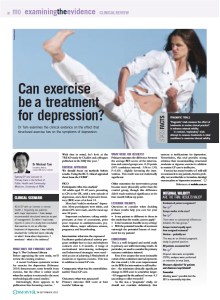 This article was published in Medical Observer.
This article was published in Medical Observer.
The article is also available on the Medical Observer website (may need registration).
Clinical scenario
As a GP with an interest in mental health, I frequently see patients with major depression. I have always recommended structured exercise as part of management. So when I read news reports in June of a study that concluded that exercise is not an effective treatment of depression, I was initially shocked! As I reflected more critically on what I knew about depression, I wondered – what is the evidence?
Clinical question
What effect does structured exercise have on symptoms of depression?
What does the research evidence say?
Step 1: The Cochrane Library
Before appraising the new study, we’ll review the existing evidence. There is a recent Cochrane systematic review for exercise for depression (up-to-date: February 2010). It demonstrates some benefit from exercise, but the effect is rather small when the analysis is restricted to the most methodologically sound studies. 1 Interestingly, there appears to be publication bias favouring exercise (“Funnel plot”, figure 3, pg 14). 1
With that in mind, let’s look at the TREAD study by Chalder and colleagues published in the BMJ this year. 2
Critical appraisal
We should focus on methods before results. Using the RCT critical appraisal sheet from the CEBM: 3
PICO
Participants: who was studied?
361 adults aged 18-69 years, presenting to GPs in the UK, with a new episode of depression, and a Beck Depression Inventory (BDI) score of at least 14. Most suffered from “mild to moderate” depression. Most participants were white, and about 60% were male, and the mean age was 40 years. Important exclusions: taking antidepressants at time of assessment, prior poor response to antidepressants, psychotic illness, major substance misuse, pregnancy and breastfeeding.
Intervention: what was the exposure?
Facilitator-guided physical activity program: multiple face-to-face and telephone contacts over 6-8 months. A range of motivational interviewing techniques and behavioural strategies were used – with an aim of achieving 150 min/week of moderate or vigorous exercise.
This was in additional to usual GP care.
Comparator: what was the control/alternative?
Usual GP care.
Outcomes: what was measured?
Primary outcome: BDI score at 4-months follow up.
Internal validity: are the trial results valid?
Randomised patient assignment?
Yes.
Groups similar at the start?
Yes. There were no substantial differences between the two groups (Table 1, pg 8). 2
Groups treated equally apart from assigned treatment?
Unclear – probably not. This was an un-blinded pragmatic study in general practice.
All patients accounted for?
Yes. Dropout rates were acceptable (20%); analyses were performed on intention-to-treat basis.
Measures objective? Or patients and clinicians kept blinded?
Somewhat. Blinding wasn’t possible but the BDI is reasonably objective.
What were the results?
Primary outcome: the difference between the average BDI scores of the intervention and control groups was -0.54 points (95% confidence interval: -3.06 to 1.99; P=0.68) – slightly favouring the intervention. This result was not statistically significant.
Other outcomes: the intervention group became more physically active than the control group, though this difference didn’t reach statistical significance at the 4-month follow up point.
External validity:
Questions to consider when deciding if these results help you care for your patients: 3
- Is my patient so different to those in the study that the results cannot apply?
- Is the treatment feasible in my setting?
- Will the potential benefits of treatment outweigh the potential harms of treatment for my patient?
Conclusion
This is a well designed and useful study in primary care with interesting results. In particular, we need to consider the primary outcome confidence interval. Even if we assume that the most favourable extent of the confidence interval represents the true result (-3.06 score improvement on the BDI) the intervention is still ineffective – the minimum clinically significant change in BDI score is somewhat larger: -4.0 (suggested by the authors) 2 or even -8.5 (according to older research). 4
As this was a “pragmatic” study, we should not conclude definitively that exercise is inefficacious for depression. Nevertheless, this trial provides strong evidence that recommending structured moderate or vigorous exercise in addition to routine GP care is ineffective.
Exercise has many health benefits so I will still be using the consultation opportunities to recommend regular exercise to my patients. However, it is probably not worthwhile to formulate detailed exercise plans as “depression treatment”.
Stat Facts
Pragmatic trials
“Pragmatic” trials measure the effect of treatments in routine clinical practice 5 to enhance external validity. In contrast, “explanatory” trials attempt to measure treatments in ideal conditions to maximise internal validity.
References
- Rimer J, Dwan K, Lawlor DA, Greig CA, McMurdo M, Morley W, Mead GE. Exercise for depression. Cochrane Database of Systematic Reviews 2012, Issue 7. Art. No.: CD004366.
- Chalder M, Wiles NJ, Campbell J, Hollinghurst SP, Haase AM, Taylor AH, Fox KR, et al. Facilitated physical activity as a treatment for depressed adults: randomised controlled trial. BMJ 2012; 344:e2758
- RCT Appraisal Sheets. Centre For Evidence Based Medicine [website]. Retrieved on 8 May 2012. http://www.cebm.net/index.aspx?o=1097
- Seggar LB, Lambert MJ, Hansen NB. Assessing clinical significance: application to the Beck Depression Inventory. Behavior Therapy 2002; 33:253-269
- Roland M, Torgerson DJ. Understanding controlled trials: what are pragmatic trials? BMJ 1998; 316:285
